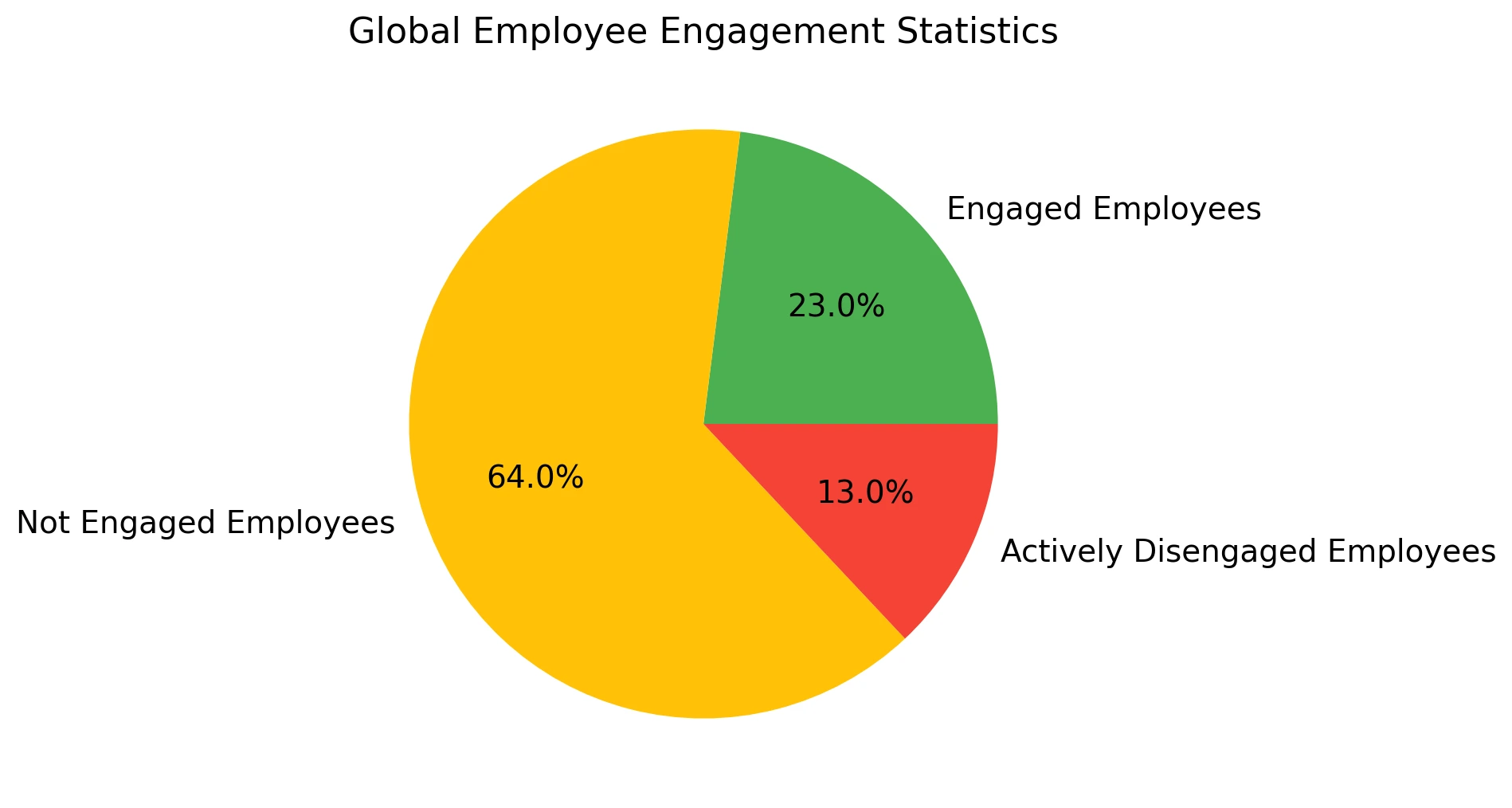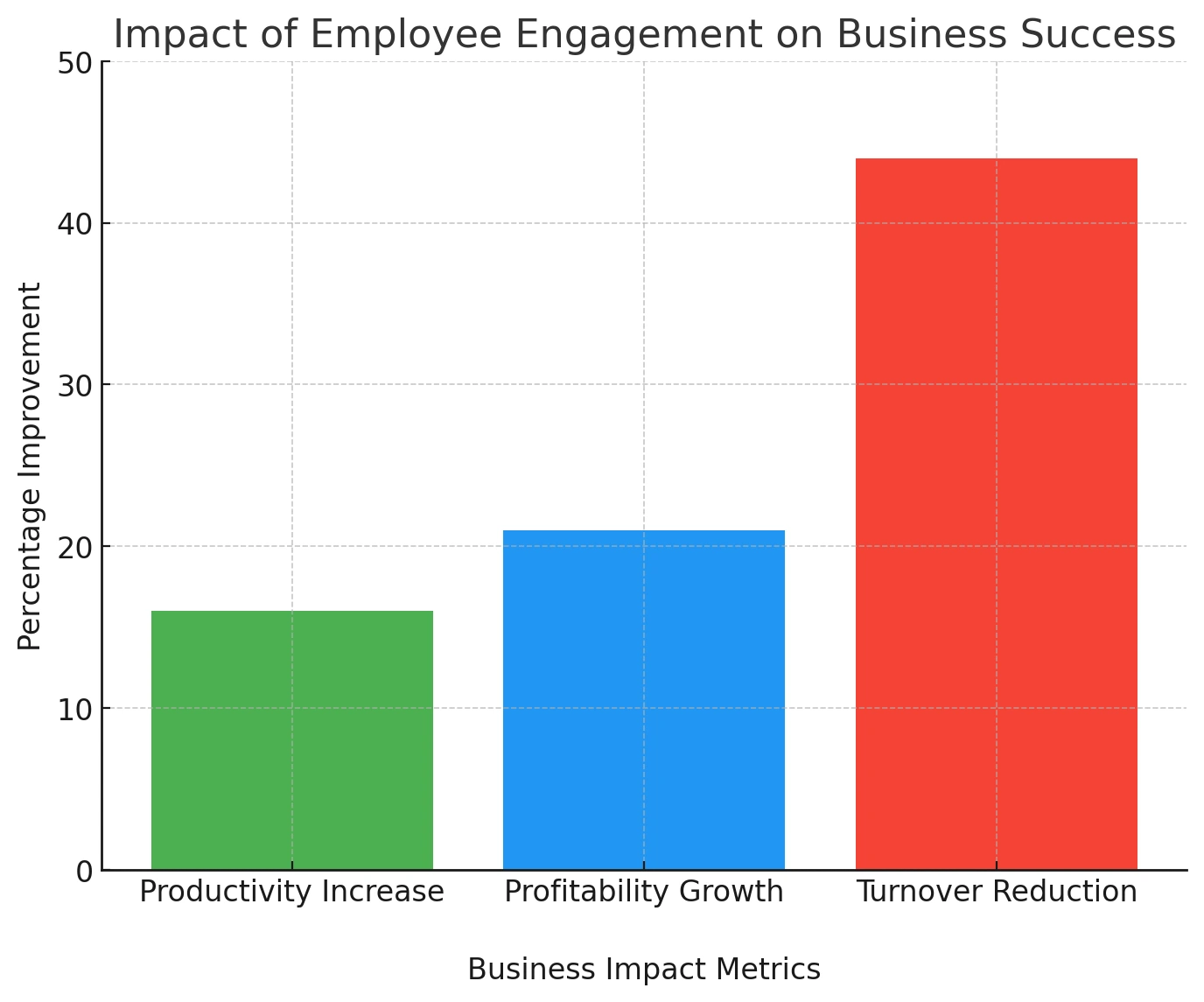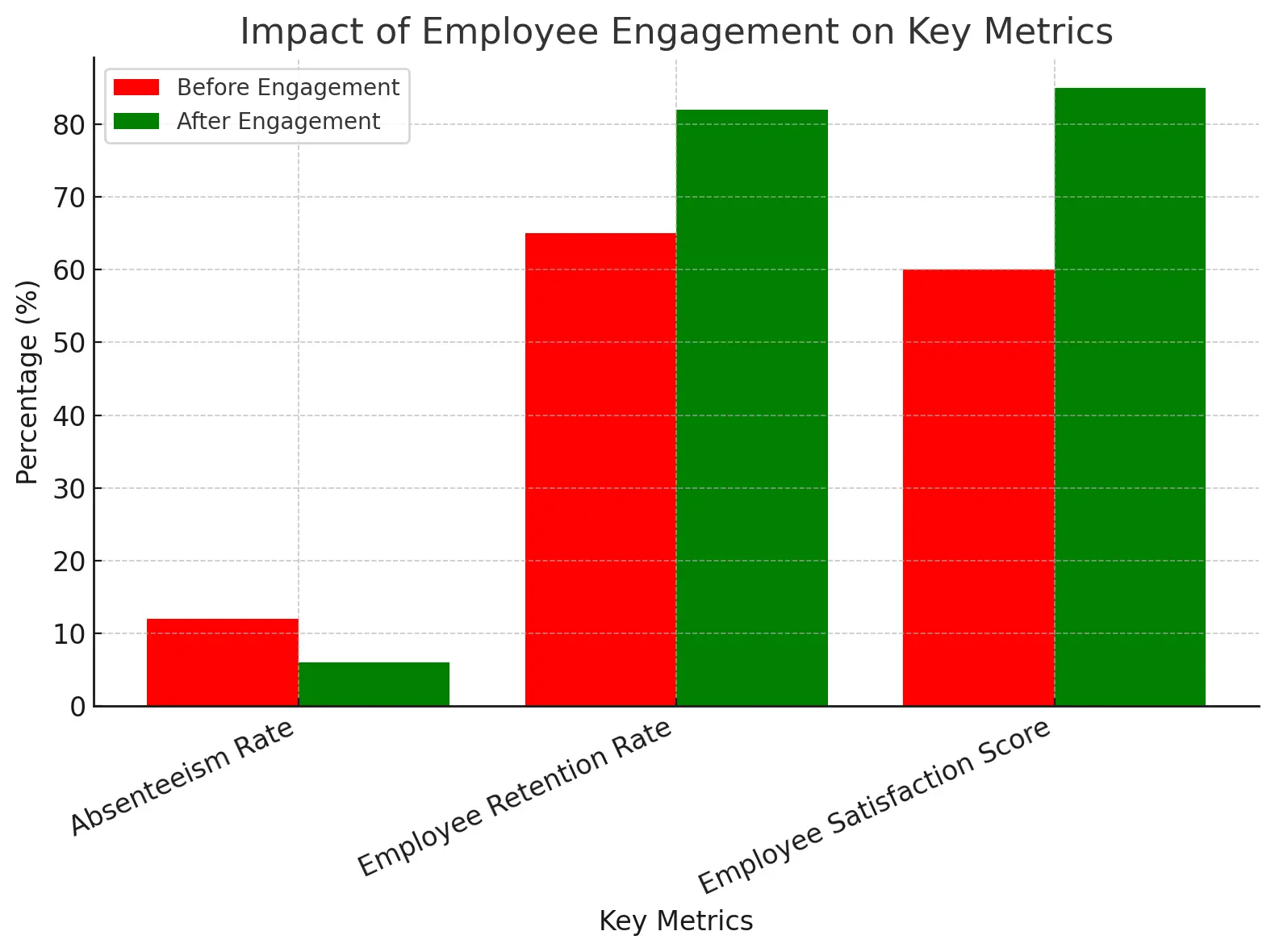

Is your team truly engaged, or are they just going through the motions? Studies show that about 15% of employees worldwide are actively disengaged, costing companies up to $8.9 trillion in lost productivity annually (Gallup’s State of The Workplace Report). Sounds disastrous, right? Well, this is where the need to improve employee engagement is perceived the most.
| Quick Summary Looking to boost team motivation, reduce turnover, and create a thriving work culture? This guide covers 15 proven employee engagement strategies that actually work. From improving communication and offering professional development to fostering a strong culture and recognizing achievements, these tips are backed by real-world case studies from companies like Google, Infosys, and Microsoft. In this blog, you’ll learn: ● What employee engagement really is and why it’s crucial for business success ● 15 actionable ways to keep your employees engaged and productive ● Key drivers like meaningful work, leadership, and recognition ● Common employee engagement challenges and how to fix them ● How to measure engagement using metrics like eNPS, turnover, and satisfaction ● Real-life success stories + future trends like AI, mental wellness & personalized programs Whether you’re an HR manager or a team leader, this guide helps you build a more connected, motivated, and high-performing team. |
Low engagement leads to high turnover, poor performance, and a toxic work culture. But the good news? You can turn things around with the right strategies. In this blog, we’ll explore practical, data-backed ways to boost employee engagement, helping CEOs, HRs, and team leaders create a motivated, high-performing team. Let’s dive in to transform workplace engagement like never before!
Employee engagement refers to the emotional commitment and dedication an employee has toward their organization and its goals. It’s more than just job satisfaction—engaged employees care deeply about their work, consistently go the extra mile, and align their efforts with the company’s mission. This connection translates into higher productivity, better customer service, and improved business outcomes.

Unlike employees who are merely clocking in and out, engaged team members are motivated to contribute their best, fostering innovation and collaboration. Thus, it goes without saying that driving employee engagement in the workplace is key to driving long-term success and organizational growth.
Employee engagement is pivotal for organizational success, influencing productivity, retention, and overall workplace morale. While there are quite a number of proven time management strategies for better productivity, here are 15 proven strategies to improve employee engagement:
Open and transparent communication promotes trust and alignment with company goals. A study by Forbes in 2022 found that open communication within teams increases engagement by 25%.

Regular updates, team meetings, and accessible leadership keep employees informed and valued. Encouraging feedback loops ensures voices are heard, promoting a culture of inclusivity.
Constructive feedback helps employees understand their performance and areas for improvement. Implementing regular check-ins and performance reviews offers opportunities for recognition and development, leading to increased motivation and job satisfaction, thereby improving employee engagement.
Investing in employees’ growth through training programs, workshops, and mentorship shows a commitment to their future. A survey mentioned in the ebook revealed that 94% of employees would stay at a company longer if it invested in their career development.
Providing clear career progression paths encourages employees to develop new skills and advance within the organization.
A positive workplace culture enhances employee satisfaction and productivity. Promoting values such as respect, integrity, and collaboration creates an environment where employees feel valued and motivated.

Facilitating teamwork through collaborative projects and open workspaces encourages innovation and a sense of community. Encouraging cross-departmental interactions allows for diverse perspectives and strengthens team bonds, something which is absolutely essential to improve employee engagement scores.
Allowing employees to take ownership of their work and make decisions fosters a sense of trust and responsibility. Empowerment leads to increased job satisfaction and innovation.
Organizing team-engagement activities, also known as team-building activities, enhances trust and communication among employees. Teams that engage in such activities report a 10% increase in productivity.
Activities like workshops, retreats, or problem-solving challenges improve collaboration and morale.
Providing options such as remote work or flexible hours accommodates employees’ personal needs, leading to increased job satisfaction. Flexibility demonstrates trust and respect for employees’ work-life balance.
Encouraging employees to maintain a healthy balance between work and personal life prevents burnout. Offering adequate leave policies and respecting personal time contributes to overall well-being and sustained productivity. This, in turn, goes a long way to improve employee engagement and retention.

Recognizing and celebrating both individual and team accomplishments boosts morale. Whether through awards, shout-outs, or company-wide announcements, acknowledging success reinforces positive behavior.
Organizing community service events allows employees to give back and fosters a sense of purpose. Corporate social responsibility initiatives enhance team cohesion and company pride.
A comprehensive onboarding process helps new hires integrate smoothly into the company culture. According to research by the Brandon Hall Group, organizations with a strong onboarding process improve new hire retention by 82% and productivity by over 70%. Providing clear expectations, training, and support from the outset sets the foundation for long-term engagement, thereby improving employee engagement in the workplace.
Regularly seeking input through employee engagement survey questions or suggestion boxes empowers employees and provides valuable insights. Acting on feedback demonstrates that their opinions matter, fostering a culture of continuous improvement.
Implementing wellness programs, mental health resources, and ergonomic workspaces shows a commitment to employees’ health. Organizations that invest in employee well-being experience a 68% higher well-being among their workforce. A focus on well-being leads to reduced absenteeism and higher engagement.
Regular recognition of employees’ hard work fosters motivation and loyalty. A Gallup survey found that employees who feel adequately recognized are twice as likely to say they’ll be with their current employer one year from now.

Implementing recognition programs or simply expressing gratitude can significantly impact engagement levels.
Implementing these strategies can significantly improve employee engagement, leading to a more motivated and productive workforce. By focusing on communication, development, recognition, and well-being, organizations can create an environment where employees thrive.

Employee engagement is a critical determinant of organizational success, influencing productivity, retention, and overall workplace satisfaction. To cultivate a highly engaged workforce, it’s essential to understand the key drivers of employee engagement that improve employee engagement scores. Below, we explore these pivotal elements.
Effective leadership is foundational to employee engagement. As Retired US Navy Admiral, Grace Hopper aptly stated, “You manage things; you lead people.”
This emphasizes the importance of leadership in fostering engagement. Leaders who communicate transparently, set clear expectations and provide guidance create a positive work environment and build trust. Supportive leaders inspire employees to perform at their best, thereby promoting a culture of motivation and commitment.
Transparent, two-way communication is essential for building trust and fostering engagement. Employees need to feel heard and valued, which means creating opportunities for them to share feedback, ask questions, and voice concerns.
Regular one-on-one meetings, anonymous feedback channels, and open forums are great ways to promote open dialogue. Leaders who communicate clearly about company goals and decisions build stronger connections with their teams, leading to higher levels of engagement and satisfaction.
Assigning tasks that align with employees’ skills and passions enhances their sense of purpose. Doug Conant, former CEO of Campbell’s Soup, emphasized, “To win in the marketplace you must first win in the workplace.”
When work is meaningful, employees are more likely to be engaged and committed. Providing opportunities for employees to contribute to meaningful projects and make a difference can improve employee engagement significantly.
Offering opportunities for skill development, training, and career advancement demonstrates a commitment to employees’ long-term success. Employees are more likely to be engaged when they see a clear path for advancement and feel invested in their professional development.
Acknowledging employee contributions is a powerful way to boost morale and strengthen engagement. Recognizing and rewarding employees for their hard work and accomplishments reinforces positive behavior and boosts morale.
A positive workplace culture brings about trust, inclusivity, and a sense of belonging, which are essential for sustaining engagement across all levels of the organization. When employees feel aligned with their company’s mission and values, they are more likely to take pride in their work and contribute meaningfully.
Creating a diverse and inclusive workplace where all employees feel valued and included fosters a sense of belonging and enhances job satisfaction. Simon Sinek also noted, “When people are financially invested, they want a return. When people are emotionally invested, they want to contribute.”
Encouraging diverse perspectives and creating a culture of inclusivity can improve employee engagement in the workplace to a great extent.
By focusing on these drivers of employee engagement, organizations can create an environment where employees feel valued, motivated, and committed to their roles, leading to enhanced performance and organizational success.
As you can well understand, employee engagement is a critical factor in determining an organization’s success. When employees are engaged, they are more committed, productive, and aligned with the company’s goals.
Let’s explore why employee engagement is essential for business success, focusing on key areas such as work culture, turnover, productivity, profitability, job satisfaction, relationships, and the connection between employees and their workplace.
A positive work culture is the foundation of a thriving organization. According to Gallup’s 2023 report, only 33% of U.S. employees were engaged, highlighting the need for organizations to focus on improving their work culture to boost engagement.
Engaged employees contribute to a collaborative and supportive environment, fostering open communication and teamwork. This positive atmosphere encourages innovation and creativity, leading to better problem-solving and adaptability.
When employees feel valued and connected to their workplace, they are more likely to contribute positively to the company culture.
High turnover rates can be costly and disruptive. Engaged employees are more likely to remain with the company, reducing recruitment and training expenses. They develop loyalty and a sense of belonging, decreasing the likelihood of seeking opportunities elsewhere. By trying to improve employee engagement, companies can retain top talent and maintain organizational stability.
Companies with highly engaged workforces are 17% more productive than those with disengaged staff. Engaged employees are more productive, drive customer satisfaction, foster a positive workplace culture, and are a key factor in financial performance.
The link between employee engagement and profitability is well-established. Organizations with a highly engaged workforce experience a 21% increase in profitability. Engaged employees are more productive, drive customer satisfaction, foster a positive workplace culture, and are a key factor in financial performance.

Engaged employees experience greater job satisfaction because they find meaning and purpose in their work. This satisfaction leads to increased motivation and a willingness to go above and beyond in their roles. When employees are content, they are more likely to stay with the company and contribute to its long-term success.
Engaged employees are more likely to provide exceptional customer service, anticipate customer needs, and create a positive customer experience.

Increased customer loyalty – Employee engagement is essential because it is vital to building and maintaining customer loyalty. Gallup also found that improving the employee experience and increasing employee engagement also leads to a 10% rise in customer ratings and a 20% rise in sales, which can result in profitability.
Engaged employees feel a strong connection to their organization, aligning their personal values with the company’s mission. This connection fosters loyalty and a sense of purpose, motivating employees to contribute to the organization’s success. When employees identify with their workplace, they become ambassadors for the company, enhancing its reputation and attracting top talent.
Thus, we would not be in the wrong to say that driving employee engagement is not just a human resources initiative but a strategic business decision. By fostering a positive work culture, reducing turnover, increasing productivity, and enhancing profitability, engaged employees drive organizational success.
Investing in engagement leads to higher job satisfaction, better relationships, and a stronger connection between employees and their workplace, creating a foundation for sustained growth and achievement.
Employee engagement is crucial for organizational success, yet many companies face challenges in fostering a motivated and committed workforce. Let’s explore common obstacles to employee engagement and strategies to overcome them.
Effective communication is the cornerstone of employee engagement. When communication channels are inadequate, employees may feel disconnected and undervalued. Gary Hamel, a renowned management expert, stated, “The real damper on employee engagement is the soggy, cold blanket of centralized authority.” This disconnect can lead to misunderstandings, decreased morale, and reduced productivity.

Solution:
Feeling underappreciated is a significant barrier to employee engagement. When employees’ efforts go unnoticed, motivation dwindles, leading to disengagement and higher turnover rates.
Solution:
David Zinger, an employee engagement expert, emphasized, “Employee engagement is the art and science of engaging people in authentic and recognized connections to strategy, roles, performance, organization, community, relationship, customers, development, energy, and happiness to leverage, sustain, and transform work into results.“
Employees who perceive a lack of career advancement opportunities may become disengaged. Stagnation can lead to decreased job satisfaction and increased turnover.
Solution:
A lack of two-way feedback can create a disconnect between management and employees. When employees feel unheard, they may lose trust in leadership and become disengaged. Without feedback, companies may also miss valuable insights that could improve processes and workplace culture.
Solution:
Excessive workload, long hours, and unrealistic expectations contribute to burnout and disengagement. Employees who struggle to balance work and personal life may experience stress, reduced productivity, and even consider leaving the company.

Solution:
Leaders play a crucial role in driving employee engagement. As John C. Maxwell said, “A leader is one who knows the way, goes the way, and shows the way.“ Employees look to their leaders for guidance, support, and inspiration.
If leadership is inconsistent, unapproachable, or lacks direction, employees may feel lost and unmotivated. Poor leadership can result in low morale, high turnover, and an unhealthy work environment.
Solution:
When employees feel they are left in the dark about company decisions, policies, or changes, it creates uncertainty and distrust. A lack of transparency can lead to rumors, low morale, and disengagement.
Solution:
Addressing employee engagement challenges requires a proactive approach. Organizations that prioritize open communication, recognition, career growth, employee feedback, work-life balance, effective leadership, and transparency will cultivate a highly engaged workforce. By overcoming these obstacles, companies can create a motivated, productive, and committed team—driving long-term success and growth.
Measuring employee engagement is essential for understanding workforce satisfaction and identifying areas for improvement. By tracking specific metrics and implementing effective feedback mechanisms, organizations can ensure a more engaged and productive work environment.
If you are looking to improve employee engagement, here are the most critical engagement metrics you must track:
High absenteeism rates can indicate low engagement levels. According to Gallup’s 2024 study, organizations with high employee engagement experience 41% lower absenteeism.
Employees who frequently miss work may feel disconnected or unmotivated. Monitoring absenteeism helps identify patterns that require attention.
eNPS measures the likelihood of employees recommending the organization as a place to work. A higher eNPS reflects greater employee satisfaction and loyalty. Regularly assessing eNPS provides insights into overall sentiment.
A high retention rate signifies that employees are committed to the organization. Tracking this metric helps assess the effectiveness of engagement strategies and identify areas for improvement.
Conversely, a high turnover rate can indicate dissatisfaction. Recent data indicates that organizations with strong engagement strategies have a 59% lower turnover rate.
Analyzing turnover data helps pinpoint underlying issues affecting engagement and guides retention strategies.
Engaged employees typically exhibit higher performance levels. Regular performance evaluations can reveal correlations between engagement initiatives and productivity.
Assessing satisfaction through employee engagement survey questions provides direct insights into how employees feel about their roles, management, and the organization. In 2024, only 30% of U.S. employees reported being engaged, highlighting the need for effective engagement strategies. High satisfaction rates often correlate with increased engagement.
There’s a strong link between employee engagement and customer satisfaction. Engaged employees are more likely to deliver exceptional service, leading to happier customers. Monitoring customer feedback can indirectly reflect employee engagement levels.
Implementing structured feedback mechanisms is essential for understanding and improving employee engagement in the workplace.
Implementing regular surveys allows organizations to gauge employee sentiments and identify areas for improvement. These surveys should be concise, anonymous, and cover various aspects of the workplace.
After collecting feedback, it’s crucial to analyze the data to identify trends, strengths, and areas needing attention. This analysis provides a foundation for informed decision-making.
Transparency is key. Sharing employee engagement survey results with employees fosters trust and demonstrates that their opinions are valued. This openness encourages continued participation in feedback initiatives.
It’s essential to act on the insights gained from feedback. Implementing changes based on employee suggestions shows a commitment to improvement and enhances engagement.
Encouraging ongoing feedback and being open to change cultivates a culture where continuous improvement is the norm. This approach leads to sustained engagement and organizational growth.
By systematically measuring engagement through these metrics and establishing robust feedback loops, organizations can develop targeted strategies to improve employee engagement, leading to improved performance and reduced turnover.
By diligently tracking these metrics and establishing robust feedback loops, organizations can effectively measure and improve employee engagement and motivation, leading to a more motivated and productive workforce.

Now, as you can well understand, improving employee engagement scores is pivotal for organizational success, driving productivity, innovation, and retention. Many leading companies have implemented innovative strategies to ensure a committed and motivated workforce.
Below are real-life examples of successful employee engagement initiatives undertaken by some of the most popular companies the world over:
Google introduced the “20% Time” policy, allowing employees to dedicate 20% of their workweek to projects they are passionate about, even if these projects fall outside their primary job responsibilities. This initiative has led to the creation of successful products like Gmail and AdSense, demonstrating that empowering employees to pursue their interests can result in significant innovations.
Salesforce aligns its employee benefits with its core values of Trust, Customer Success, Innovation, Equality, and Sustainability. The company offers comprehensive wellness programs, generous parental leave, and opportunities for volunteerism through its “1-1-1” philanthropy model, where 1% of equity, 1% of product, and 1% of employee time are donated to charitable causes. This alignment reinforces a sense of purpose and belonging among employees, boosting engagement.
Tata Consultancy Services (TCS) emphasizes continuous learning and work-life balance through initiatives like the “Corporate Digital Academy” and “Maitree.” The Corporate Digital Academy offers employees access to advanced digital courses, enhancing their skills and career growth.
“Maitree” focuses on employee engagement activities, fostering a sense of community and well-being. Additionally, TCS promotes work-life balance through flexible work arrangements and wellness programs.
Infosys implemented the “iCount” program to acknowledge and celebrate individual employee contributions. The initiative includes peer recognition platforms, performance-based rewards, and opportunities for professional growth. By valuing each employee’s efforts, Infosys fosters a culture of appreciation and engagement.
HCL Technologies adopted the “Employee First, Customer Second” (EFCS) philosophy, empowering employees to take the lead in customer interactions and decision-making. This approach decentralizes authority, encourages transparency, and places trust in employees’ capabilities. As a result, HCL experienced increased employee engagement, customer satisfaction, and innovation.
Microsoft fosters a “growth mindset” culture, encouraging employees to embrace challenges, learn from feedback, and continuously develop their skills. The company provides ample learning resources, mentorship programs, and supports internal mobility. This culture of continuous learning and development enhances employee engagement and performance.
Hilton hosts an annual “Team Member Appreciation Week” to recognize and celebrate employees’ hard work and dedication. The event includes various activities, rewards, and opportunities for team members to share their stories. This initiative strengthens the sense of community and appreciation within the organization, leading to higher engagement levels.
Here’s a tabular representation of the key takeaways from these case studies and provide actionable insights for organizations aiming to improve employee engagement:
| Company | Initiative | Actionable Insight |
| 20% Time Policy | Encourage employees to dedicate time to passion projects to drive innovation and job satisfaction. | |
| Salesforce | Alignment of Benefits with Core Values | Design employee benefits that reflect and support the company’s core values to promote a motion-driven culture. |
| Tata Consultancy Services | Corporate Digital Program and Maitree Programs | Invest in skill-building and community-building activities to promote continuous learning and well-being. |
| Infosys | iCount Program | Implement recognition programs that celebrate individual contributions to boost morale and motivation. |
| HCL Technologies | Employee First, Customer Second Strategy | Empower employees and prioritize their needs to enhance engagement and customer satisfaction. |
| Microsoft | Growth Mindset Culture | Foster a culture that encourages learning, resilience, and personal development to improve employee engagement. |
| Hilton | Team Member Appreciation Week | Regularly recognize and celebrate employee efforts to strengthen loyalty and a sense of belonging. |
By adopting these strategies, organizations can create an environment where employees feel valued, motivated, and committed to their work, leading to overall business success.
Employee engagement is evolving, influenced by technological advancements and a growing emphasis on well-being. Understanding these future trends is extremely important for organizations aiming to develop a motivated and productive workforce.
Artificial Intelligence (AI) and technology are transforming how organizations improve employee engagement.
AI-powered systems analyze employee data to tailor experiences that resonate with individual preferences and needs. A recent study found that companies utilizing AI-powered platforms experienced a 35% increase in employee engagement within six months of implementation. This personalization enhances job satisfaction and fosters a deeper connection to the organization.
By analyzing communication patterns and feedback, AI offers real-time insights into employee morale. These data-driven insights enable proactive interventions to address potential disengagement.
Automation of routine tasks allows employees to focus on more meaningful work, increasing engagement and productivity. A Deloitte report indicates that over 60% of business owners believe AI increases productivity by streamlining job processes. AI handles administrative duties, freeing up time for creative and strategic activities.
AI assesses individual learning styles and career aspirations to recommend tailor-made development programs. This customization ensures employees acquire relevant skills, promoting continuous growth and engagement.
Through predictive analytics, AI identifies early signs of disengagement or burnout. A study by IBM showed that predictive analytics reduced employee turnover by 30% in AI-integrated companies. This foresight allows for timely, targeted interventions to maintain a motivated workforce.
Employee well-being is becoming a central component of engagement strategies.
Organizations are implementing wellness initiatives that address physical, mental, and emotional health. These programs may include fitness challenges, mental health days, and access to counseling services.
A survey revealed that 59% of employees reported higher job satisfaction due to the introduction of AI in their workplace, which can include wellness applications.
Offering flexible schedules and remote work options helps employees balance professional and personal responsibilities, reducing stress and improving employee engagement and motivation.
Cultivating a culture that prioritizes empathy, open communication, and support encourages employees to voice concerns and seek assistance when needed. This environment brings about trust and loyalty.
Access to mental health resources, such as counseling services and stress management workshops, demonstrates an organization’s commitment to employee well-being. This support can mitigate burnout and promote sustained engagement.
Promoting a healthy work-life balance through policies that discourage overwork and encourage taking time off helps maintain employee well-being and satisfaction.
By embracing AI and technology to personalize experiences and by prioritizing mental health and well-being, organizations can adapt to future trends in driving employee engagement in the workplace, leading to a more committed and productive workforce.
Conclusion
Employee engagement is the backbone of a thriving workplace, influencing productivity, retention, and overall business success. By fostering open communication, recognizing employee contributions, and leveraging AI-driven insights, organizations can not just improve employee engagement significantly but create a motivated and high-performing workforce as well.
Additionally, tools like Clockdiary, a leading time-tracking software, can improve employee engagement in the workplace. Clockdiary offers features such as real-time time tracking, comprehensive reporting, tracking employee productivity by AI rule engine, AI smart screen Insights, AI-powered smart assistant, and seamless integration with various platforms like Slack, Trello, and Jira, enabling organizations to monitor productivity and identify areas for improvement.
This helps employees manage workloads efficiently, prevent burnout, and maintain a healthy work-life balance. Prioritizing engagement through modern strategies and digital solutions leads to a more satisfied, committed team. Investing in employee experience today will drive long-term growth, innovation, and a positive company culture for the future.

Frequently Asked Questions:
The biggest challenges to employee engagement include poor communication, lack of recognition, limited career growth opportunities, work-life imbalance, and ineffective leadership. These issues can lead to disengagement, low morale, and high turnover if not addressed with proactive strategies.
Small businesses can improve employee engagement on a budget by encouraging open communication, recognizing employee achievements, and offering flexible work arrangements. Providing professional growth opportunities through mentorship, cross-training, and free online courses can also boost motivation without significant costs.
Yes, employee engagement can be measured without surveys by analyzing key metrics such as absenteeism, productivity levels, employee turnover rates, and real-time feedback from performance evaluations. Not just that, AI-driven sentiment analysis, one-on-one check-ins, and monitoring collaboration patterns can provide valuable insights into engagement levels.